Being Black in Shaker Schools
Students say their experiences are marked by systemic inequity, isolation and microagressions
Junior Rhazariah McFall is a member of choir and takes French. “Just as a starting step, effort would be monumental for change,” she said.
Halfway through the Nov. 8 meeting, senior Brianna Jarrell stepped up onto the stage. She took the microphone from Substitute Principal David Glasner and expressed frustration about how she and her friends had been treated after school.
“I get that the whole, ‘Students are a priority,’ and everything, but I don’t believe that they’re listening to us, because they’re too busy saying that we’re up to something. Especially us minority students,” Jarrell said, who explained that when she sat alone in the egress after school, no staff addressed her. But, she said, when she sat there with friends, security staff told them they had to “move on.”
Jarrell also spoke about disparities in the experiences of white and black students at Shaker, especially when it comes to discipline. But, she continued, “It’s not even just our school; it’s our society.” She said people presume that any group of minority students is doing something wrong.
Other black students followed Jarrell’s lead.
Junior Olivia McDowell took the microphone and explained that she was the student whose complaints were used to put English teacher Jody Podl on administrative leave in October. The Shaker Heights Teachers’ Association authored a letter criticizing the administration’s actions and alleging that Podl was not given due process because she was reprimanded without having a chance to respond to allegations. The district later apologized for its treatment of Podl.
The letter also stated that Podl had spoken with a student who had not completed an assignment and that the student “misconstrued some of the questions that Jody asked and was very upset.”
“I’m Olivia McDowell. I’m a junior and I’m the student that they’re referring to in that letter,” McDowell told the audience.
She went on to criticize the inequity of enrollment in upper-level classes at the high school, and she questioned the district’s efforts to address equity.
Equity denotes freedom from bias or favoritism, a state of fairness and impartiality. And while students don’t believe they are being blatantly discriminated against because of their race, some believe that they are treated differently.
“I don’t want to get emotional, but I care about my education,” McDowell said during the meeting. “Y’all sweep stuff under the rug and act like it just doesn’t matter — act like it’s not going on. I don’t get it. What about the damage to a student when they’re, what, one of three, one of five black kids in their class because of the whole education gap that y’all have?”
The Shakerite talked with these students and others and asked them to reflect on their experience in Shaker, including any experience with racial inequities.
Students interviewed said inequity stems from a lack of resources promoted among or given to black students.
Jarrell said Shaker needs to inform students about resources such as study circles more often. “I just feel like the acknowledgement of certain resources aren’t brought up enough, and I feel like that will help take the programs to another level,” she said.
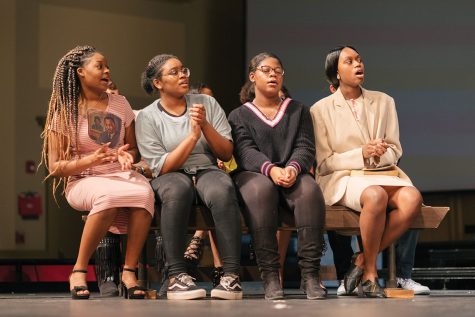
Senior Brianna Jarrell, on the right, performs in Sankofa Feb. 23. She is a MAC Sister Scholars leader and a drama, task and multimedia leader for Sankofa.
The high school’s study circles are after-school opportunities to get help from teachers in the four core subject areas: history, math, English and science. Study circles are offered for two hours after school once a week per subject.
Study circles were created in the early 2000s after Dr. John Ogbu, an anthropology professor at the University of California at Berkeley, studied reasons for the achievement gap at Shaker. In his resulting 2003 book “Black American Students in an Affluent Suburb,” Ogbu concluded that black students believed they were academically inferior to white students and thus excluded themselves from higher-level courses. He also concluded that teachers contributed to those feelings of subordination.
This finding sparked conversation within the community about how to help minority students succeed in school. Study circles were started under a grant secured by Terry Pollack, who taught social studies at Shaker for 50 years. His goal was to provide support for African-American students in Advanced Placement classes. The district eventually took over funding for study circles.
Originally available only to African-American students, study circles were later opened to all students. Disagreements about how to compensate the teachers who lead study circles nearly ended them last year and delayed their start until Oct. 22 this year.
Teachers should extend resources to students if they need help, Jarrell said. Teachers could help “by telling students when the study tables are, or when and where there’s tutoring centers and reaching out to peers,” she said.
“I feel like a lot of the students feel like the teachers don’t care, and then they kind of just give up,” she said.
McDowell also said that resources are not equitably available. “I feel like they’ll give certain students the tools needed for them to strive and for them to do what they have to do to become successful,” she said.
McDowell didn’t provide any specific examples of such tools, but said she has heard of “certain students getting more extra credit opportunities, or some students not being aware of what was needed in order to move forward into the IB Diploma Programme until it’s too late.”
Science teacher Sharita Hill said she thinks there’s more inequity across the levels of classes than within individual classrooms. “I do see the inequity in the higher-level courses as it goes down to the lower-level courses,” she said.
Science teacher William Scanlon also noted inequity in the leveling of courses.
“I don’t think there’s a lack of fairness that could be attributed to black and white, but sometimes over the years, I feel like [the district] gives more attention to the AP and IB students than they do to the lower-level students and middle students,” Scanlon said.
Scanlon said the inequity can be attributed to how much money is being directed toward the IB program instead of to lower-level classes. He said smaller classes would benefit students. “When it’s a big class, the kids don’t get the individual attention they need, and the lower-level kids, especially, need that attention,” he said.
Because most IB Diploma Programme students are white, the district’s investment in that program can amplify the belief that white students are valued more than students of color.
Hill said her students have said that her expectations are much higher than other teachers’. “They say their white teachers let them do whatever they want because they don’t care,” she said.
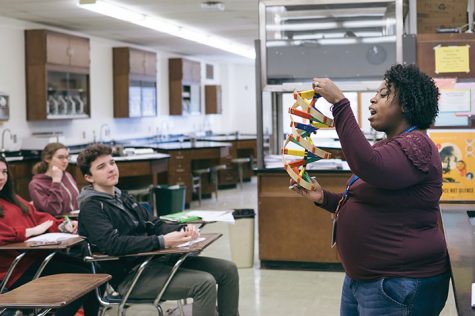
Science teacher Sharita Hill teaches four classes and is a co-adviser of SGORR. “No matter what level or race the students are, I try to treat them with the same level of respect,” she said.
“Students have told me that other teachers never give them homework assignments, reading assignments, or make them research projects. I think this has negatively impacted these students because these skills are important to learn and perfect no matter what academic level these students are at,” she said.
Hill said it upsets her students have come to her and said their other teachers don’t care what they do, because she knows everyone is capable. “No matter what level or race the students are, I try to treat them with the same level of respect,” she said.
Hill said many of the general-level biology students that she taught did not achieve at full potential because the curriculum is not as engaging or as rigorous as that of upper- level science courses.
“And I don’t know if they are being pushed enough or as much as we are pushing our upper-level students, and I think we can,” she continued.
Students also said that teachers approach black and white students differently.
Senior Jeremiah Caver said that teachers have spoken to him in a more “simple-minded” way.
“They talk to you like you won’t understand [the way] they talk to the rest of the class,” he said. Caver said he sees information being taught to his white friends at a fast pace, but the teacher will explain the information to him slowly, as if he wouldn’t be able to understand it otherwise.
Sophomore Zaria Thomas said sometimes teachers critique only black students about not doing their homework — when white students didn’t do their homework, either.
Thomas said one way to make school more equitable would be to treat everyone equally.
Senior Kayla Young said she’s had teachers who treat black and white students differently. “Just treat us all the same,” she said. “We’re all going to do the same work.”
For example, Young said that one teacher pushes black students harder than white students and more strictly enforces rules for black students.
Junior Sariah Wright came to a similar conclusion — she thinks teachers have lower expectations for her because of her race. “It makes me feel like I’m less than what I am,” she said. Wright said, for example, that teachers pass back tests and express disappointment in a white student’s performance but not in hers.
Students elaborated on McDowell’s comment about minority enrollment in advanced classes.
Senior Corin Manning said she feels disrespected due to her race. She said some classmates’ attitudes seem to communicate, “Why are you here?”
Junior Rhazariah McFall has grown used to being one of the only black students in her classes. “Usually the minority is in the less advanced classes, which is weird,” said McFall, who added that she is not sure why and is curious.
Scanlon said there aren’t as many black students in his honors-level classes as in his mid-level and lower-level classes. “As far as numbers are concerned, as far as data of black and white kids are concerned, it’s definitely unequal,” he said.
A data analysis by Hanover Research during the 2015-16 school year found that 4.9 percent of black sophomores were enrolled in at least one AP or IB course, while 62.8 percent of white students were. Also, only 11.3 percent of black juniors were enrolled in at least one AP or one IB course, while 67.9 percent of white juniors were.
Students can feel uncomfortable when outnumbered in class.
“I’m not black, but it feels pretty awful because I know what it feels like to be the only person in the room that is your race because I’m biracial: half Asian, half white,” sophomore Aine Jameson said.
Jarrell spoke of a similar experience. She said in some of her classes, she doesn’t feel comfortable working with anyone. “I just won’t speak and I’ll just work by myself,” she said.
Hill said that when forming groups during class, her black students will create groups together, and her white students will mostly do the same. “You’ll see the big divisions within the classroom, and that’s across all of the classes I teach,” she said.
The lack of integration in classes is disturbing, Hill said. “It does in a way make me feel upset because for Shaker to be marketed as such a diverse school, the diversity within each classroom doesn’t seem like it’s where it should be,” she said.
Junior Cecilia Zagara said racially unbalanced classes limit discussions.
“I know in my econ class we always have these really deep conversations, but the class is practically all white, so it’s just a bunch of white people talking about white people,” said Zagara. “We’re not hearing the other side, and the other side isn’t hearing what we have to say.”
McDowell said it’s hard when she’s one of just a few black students in a classroom. “Say a question comes up about race; all of a sudden you’re supposed to be the voice for the whole African-American community, and all people think different ways,” she said.
McDowell said that the isolated feeling has grown familiar. “I’m very used to it, because that’s how Shaker has been for a very long time,” she said.
“I guess it feels normal because usually my classes are like that,” Weatherspoon said.
Zagara said students practice self-segregation. “I feel like you’re always more comfortable around your friends, and if your friends are the same race as you, you’re going to be comfortable around them and act differently around them than new people that might be a different race,” she said.
Black students do segregate themselves within the classroom, said Caver, because, if there’s only two or three black kids, they think, “We gotta stick together.”
Manning said in her high school experience, she felt alone because of such segregation. “I felt completely isolated. It was just me and this other black boy, and we would just sit together and try to help each other with the work. Nobody else wanted to help us. I was kind of scared to ask for help,” she said.
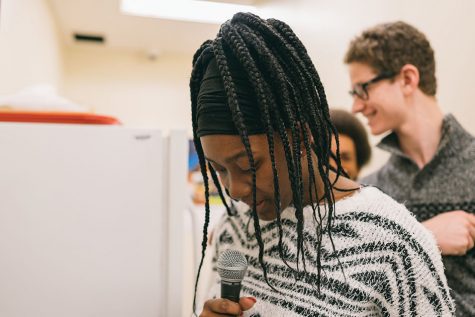
Senior Corin Manning reads the morning announcements. She is president of Shaker’s student NAACP and a member of the Student Leadership Team.
Senior Nasir Rashid said he is one of two black males in his grade who takes IB classes. “It makes me feel bad because I want to have other people that look like me in these classes,” he said.
Another cause of inequity students noted was microaggressions from teachers or other students.
“Microaggressions are subtle words or actions that have this unintentional but slightly aggressive meaning to them that typically makes the person that it’s being directed toward feel uncomfortable or abnormal,” junior Tiffany Hsich, who is a SGORR leader, said.
Rashid said a lot of people can say something racist by accident. He said it’s something that’s “unfortunately a part of the real world.” He offered an example that occurred outside of school. He said at his job one time, a person asked him if he rolled his blunts like he was wrapping his burrito. Rashid told the customer that he has never smoked marijuana.
Jameson said she notices when white teachers use slang or change their tone of voice to sound less formal. She said she thinks teachers do this to try relate to black students. “At first you kind of don’t pick it out as wrong, because you don’t really notice it, but I realized that there’s a definite difference between being white and being black besides just your skin color. It’s definitely in the way you’re treated,” she said.
“I feel sometimes that it’s very intentional. They know what they’re doing.”
Young said she noticed that white students who ask a black student to do something will sometimes ask differently than if they were asking another white student. “They will try to come off way nicer than they really are, because they think we’re going to get aggressive or something like that,” she said.
Microaggressions can lurk in compliments, Caver said. When people offer praise by saying, “You’re so articulate,” the statement implies that the person who made that comment doesn’t expect him to be.
Such slights are hard to understand if people don’t experience them every day, Caver said. “[White students] won’t explicitly treat you different, but it will be more subtle,” he said. “Some people just don’t see it. Either they don’t know what they’re looking for, or they have no idea that the problem exists.”
Scanlon said he noticed that some students are unintentionally treated differently because of their race. “Sometimes, I don’t even think the administrator or teacher knows that they’re doing it,” he said. “It’s not a conscious thing, it’s a society thing.”
Caver continued, “It’s because of how systematic everything is — that it is that way — and that people don’t broaden who they talk to and who they hang out with outside of the classroom.”
McDowell agreed that achieving equity is a systemic struggle. “It’s not a surface issue. It’s built in, and it’s going to take time for everyone to move forward and advance their thought on equity, on equality, and how to treat each other,” she said.
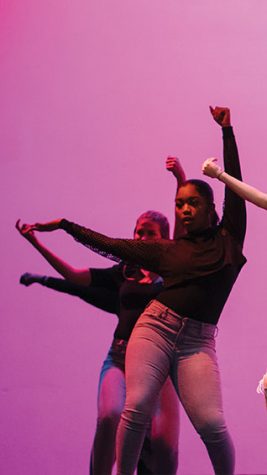
Junior Olivia McDowell performs a choreographed dance for Sankofa Feb. 23. She is in Fashion Club, competes as a varsity cheerleader and is a dance leader for Sankofa.
Rather than understanding what each student needs, Hill said, biases dictate how we talk and act. “We are looking at students as groups of populations, and we have to stop doing that,” she said.
Hill said we need to acknowledge that we have biases and that every student learns best in different ways. “Everyone is going to be different in that respect,” she said. “Each of these students are independently learning best in different ways. Then we can start to approach them in different ways.”
“I think we need to identify that there is a problem first. I think that’s the one thing that’s hard to admit, even through our personal biases,” Hill said. “I think a lot of it is unintentional.”
The district is taking steps to bridge these achievement and equity gaps. One example is the Bridges Program, a three-week summer program for minority and disadvantaged students to develop study skills and introduce the content for Honors, AP and IB Diploma-level courses. Students and faculty meet monthly during the school year. It is directed by social studies teacher Sarah Davis and co-advised by social studies teachers Joseph Konopinski and Brian Berger.
Shaker also created the Equity Task Force three years ago. Its mission is “exploring the assets and challenges of embracing and moving toward equity for all students,” according to shaker.org. The district also lists 19 groups that assisted the task force and collaborate to increase equity. Examples include Neighbor Nights, SGORR and Fathers Committee.
Teachers and students agreed there isn’t a clear-cut solution. If there was, the problem would no longer exist.
McFall said the first step is effort. “First, address the problem face on,” she said. “Some people will say there’s not a problem, but there obviously is.”
“We always talk about how diverse Shaker is, but there are problems that we don’t talk about, like the inequity between races,” McFall said. “If they just gave an effort — that would be so much better than talking, and then on to the next thing. Just as a starting step, effort would be monumental for change.”
Caver said he knows what will help. “It would simply be to encourage the students to broaden their horizon, and if they’re in a class that they’re getting easy A’s, then try to get them to take the next step and let them know that this can help them in the future.”
Students offered ideas to bridge the achievement and equity gaps.
Weatherspoon said Shaker should take more of a restorative practice approach by convening an assembly about race and equity and holding discussions during classes afterward.
Thomas said the school should make announcements to encourage people extend their social interactions. They should say, “Make a new friend of a different color. Venture outside your comfort zone,” she said.
Thomas also said she thinks teachers should intentionally pick groups to mix up the races.
Scanlon finds that sometimes he reorganizes student groups for that reason. “I feel like they sometimes do isolate themselves,” he said.
Hill said, “I design lab groups where I try to make the populations as diverse as I can.”
Young doesn’t think there is a solution to making classes more diverse “unless they handpicked the classes, and that’s going to take too much time.”
Everyone should want to push themselves, said Rashid, even though it might be hard. “I knew IB was going to be hard, but one of the reasons I entered it was to show the way it could be diverse,” he said.
Scanlon said he wish he knew the answer because inequity has been a problem for all 23 years he’s worked at Shaker. He said, “I think that the school should never stop doing things and trying to find the best plan to help it be more equitable.”
The Shakerite’s continuing coverage of equity concerns will examine the role academic tracking in elementary school plays in high school class enrollment.
Comment using your Facebook, Yahoo, AOL or Hotmail account
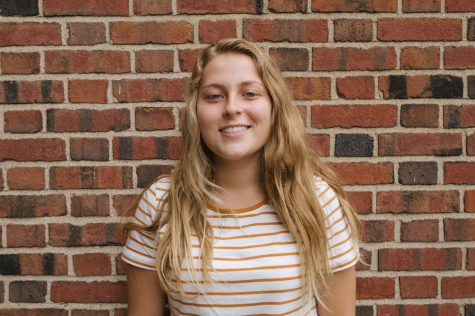

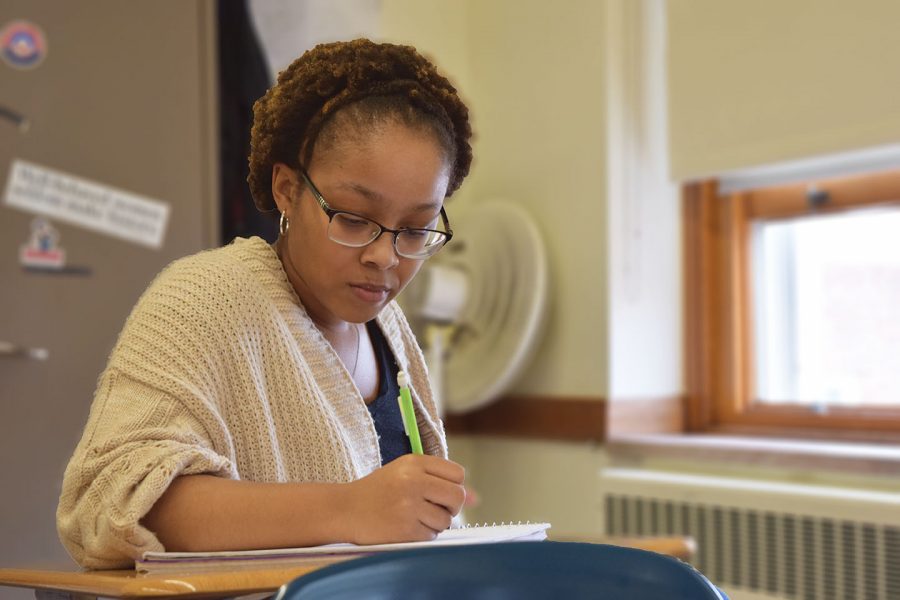

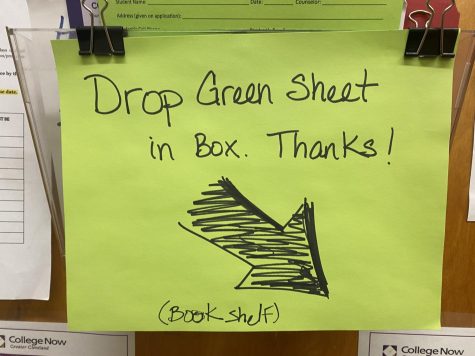



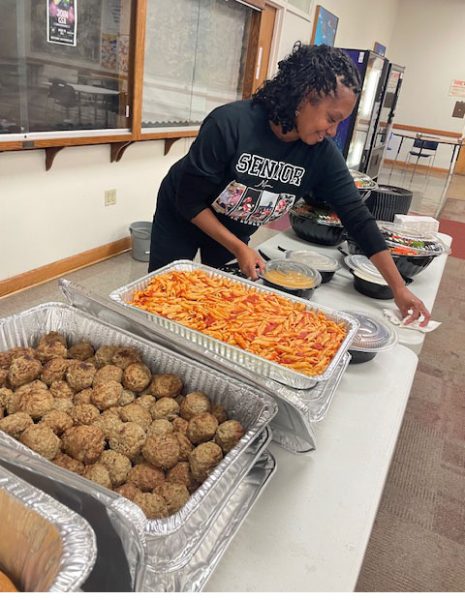
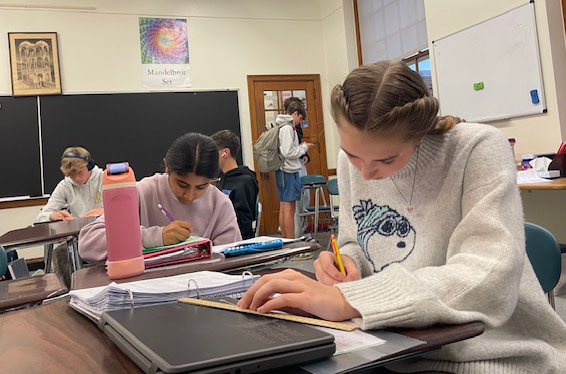
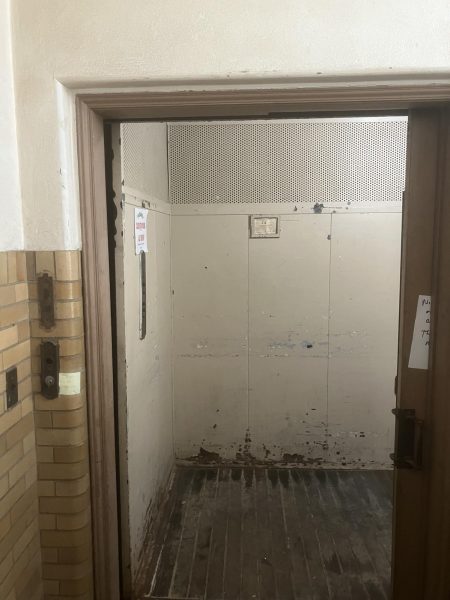
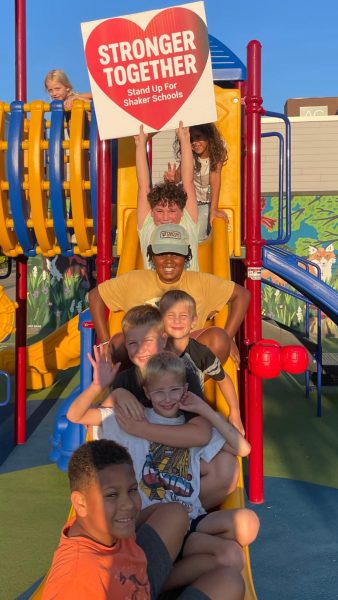
Glenn | Feb 15, 2020 at 12:05 pm
If it has not already been done, it would appear to me that a better study to figure out how to raise the achievement of black students would be to analyze the study habits, the skills, the family situation, the income, etc of the high achieving black students vs the low achieving students to find out the major reasons for the discrepancies within their race. If there are tangible reasons that can be uncovered it would seem that the district should use that information first to quickly try and adapt those under-performing students to routines and skill set of the high achieving ones. Just trying to make the racial makeup of each class look better on paper with a few cursory changes may make many feel better but ultimately will not solve the problem. As for all the mention of microaggressions and perceived disrespect, those are red herrings that will waste a lot of district time but not move the needle. Those issues will inevitably go away when the black students begin achieving at higher levels, which will only come about when a real commitment is made to understand why they aren’t achieving in the first place.